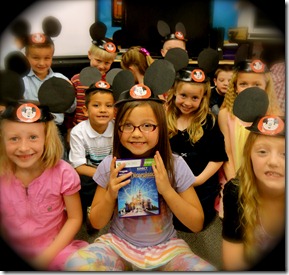Engaging Young Students in Knowledge Building and Critical Thinking
We are two weeks away from the Microsoft Partners in Learning Global Forum (#PiLGF) in Prague, Czech Republic. I wanted to share another guest post from a member of “Team USA” (one of the 16 teachers who will be representing the U.S. at this amazing professional learning experience). Today’s post is from educator Cheryl Arnett ( @c_arnett ) featuring a project done with collaborating educator Melany Neton. The project is called Let’s Go to Disneyland and won runner-up in the Knowledge Building & Critical Thinking category at the Partners in Learning 2012 US Forum . Cheryl is a 1st/2nd grade teacher at Sunset Elementary, Craig, CO. This will be Cheryl’s second Global Forum. You can also find her blogging on Huffington Post .
Imagine the look on the face of a six-year-old child entering a classroom and discovering an Xbox 360 Kinect gaming system!
Their curiosity and excitement quickly turn to inspiration and motivation when the games are used for learning. Early interactions with Kinect games in my classroom offered opportunities to practice basic math and listening skills. Each game holds a multitude of possibilities for academic lessons. One particular game, Disneyland Adventures, provided a basis for an amazing unit of learning for first and second grade students. (To see the full project and supporting classroom resources, check it out on the Partners in Learning Network).
Using the Kinect game as a final virtual destination, young children worked in collaborative groups to plan a vacation of their dreams. Working on SkyDrive One Note Documents, the teams researched and planned their trips. Using actual online travel and vacation sites, they located Disneyland on a map, compared transportation options, researched hotels, and explored the rides in the park. Working well beyond math skills typically expected of first and second graders, the children calculated costs of driving versus flying. They had to negotiate and make decisions in their group as they considered not only the travel variables, but also how the length of their stay and hotel choice would affect the costs associated with their final plans.
The virtual trip on the Kinect sparked their young imaginations and the trip to Disneyland become quite real in their minds. The students not only planned, but wrote journal entries of their experiences and created post cards to send to their families and friends.
Listen to their reflections in this video clip:
[View:https://www.youtube.com/watch?v=uIYQ-MBbwbo&feature=share&list=UUH3e6gUw2XjKRnN1vd5bgrg]
Our project reinforces two important points in education. The first is that children are never too young to begin learning 21st century skills. Six and seven year old children easily and enthusiastically tackled a challenging problem, applying critical thinking and collaboration skills as they learned to work together and built knowledge beyond their years with passion and purpose. The second is the importance of play and imagination in learning. By tapping into their dreams and creative nature, the project became successful beyond our expectations. The students couldn’t wait to learn. They truly understand that the difference between a dream and a goal is a plan.
Kinect offers a new dimension to learning. Our experiences are still growing as we have incorporated Avatar Kinect into our lessons this year. The possibilities for communication and creation are many! Never underestimate the potential of young children. If they are given the opportunity to explore, create, and build knowledge using technology with access to the world at six, think what they can be doing at sixteen!
 Cheryl Arnett @c_arnett
Cheryl Arnett @c_arnett
Sunset Elementary School
Craig, Colorado, USA
See related posts:
- Guest post: The 21st century science project
- Guest post: On A Mission to Stop Bullying with the Canastota Apprentice
- Finalists for the Microsoft Partners in Learning 2012 US Forum
- Students Impact Change in Times of Crisis
- Educator Combines Biology and Gaming with Kinect to Engage Students and the Community
- Delivering Success through Technology for Students with Disabilities